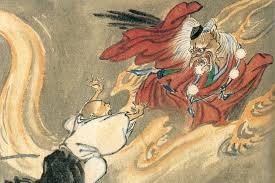Demon Slayer and Japanese Mythology: How Legends Shape the Story!
As an anime enthusiast, I’ve always been intrigued by how Japanese culture and mythology influence storytelling. One series that masterfully blends these elements is Demon Slayer: Kimetsu no Yaiba. This anime not only captivates audiences with its stunning animation and intense battles but also weaves in deep-rooted references to Japanese folklore, historical elements, and traditional beliefs. If you’ve ever been curious about the myths that breathe life into this tale, you’re in for a fascinating exploration.
The Influence of Yokai and Oni in Demon Slayer
At the heart of Demon Slayer lies the conflict between humans and oni (demons). In Japanese mythology, oni are feared supernatural creatures known for their immense strength and destructive nature. Traditionally depicted as large, horned beings with grotesque features, oni symbolize chaos and malevolence.
Muzan Kibutsuji, the series’ main antagonist, epitomizes the essence of oni. His ability to transform humans into demons and his overwhelming power align with the mythological concept that oni can corrupt and consume souls. This parallel between folklore and fiction adds a compelling depth to the series.
Tanjiro Kamado: The Hero with Mythological Roots
Tanjiro embodies the classic hero archetype seen in Japanese folklore—compassionate, resilient, and unwavering in his moral compass. His journey to save Nezuko and rid the world of demons mirrors the principles of Bushido, the samurai code emphasizing honor, loyalty, and self-discipline.
His Hanafuda earrings carry historical and cultural significance, resembling symbols found in traditional Japanese card games and linking his lineage to a powerful legacy.
Nezuko Kamado: The Demon with a Human Heart
Nezuko’s transformation into a demon while retaining her humanity reflects themes from Japanese legends where cursed beings grapple with their duality. Her bamboo muzzle is reminiscent of ancient practices aimed at suppressing evil influences, reinforcing her struggle to control her demonic instincts.
The Twelve Kizuki: Echoes of Myth and Karma
Muzan’s elite demons, the Twelve Kizuki, reflect various elements of Japanese mythology and Buddhist beliefs. Their tragic backstories and abilities often embody concepts like karma and reincarnation. Daki and Gyutaro’s bond, for example, mirrors familial karma seen in traditional legends, where past deeds dictate fate.
Breathing Techniques and Traditional Martial Arts
One of the most unique aspects of Demon Slayer is the breathing styles used by the Demon Slayer Corps. These techniques draw inspiration from real-life Japanese martial arts, where controlled breathing enhances combat effectiveness. The elemental themes—fire, water, wind—align with Shinto principles, which emphasize harmony between humans and nature.
Mount Natagumo and the Spider Demon Arc
The eerie Mount Natagumo arc is a tribute to Japanese ghost stories, particularly those featuring tsuchigumo—mythical spider creatures known for their cunning and ability to ensnare victims. The tragic fate of the spider demon family echoes yurei (ghost) and onryo (vengeful spirit) legends, reinforcing the horror elements within the narrative.
The Hashira: Inspired by Samurai and Deities
The elite Hashira warriors reflect the legendary Seven Samurai trope, where each member possesses distinct philosophies and fighting styles. Their flamboyant appearances and techniques bear similarities to revered figures in Japanese mythology. Rengoku’s fire motif, for example, is reminiscent of Kagutsuchi, the Shinto fire god.
The Sun and Moon Symbolism
The celestial bodies play a crucial role in Demon Slayer. The Hinokami Kagura (Dance of the Fire God) and its link to Sun Breathing underscore Japan’s reverence for the sun as a life-giving force. Conversely, the moon’s association with darkness and mystery resonates with formidable demons like Kokushibo, symbolizing the eternal struggle between light and shadow.
Traditional Festivals and Rituals
References to Japanese customs, such as the Obon Festival (a time for honoring ancestors), are subtly woven into the storyline. The dedication of the Demon Slayer Corps to protecting humanity echoes these cultural traditions of respecting spirits and maintaining balance.
Adsy.Pw/Hb3 – Features, Benefits, and Safety Insights!
The Central Theme: Light vs. Darkness
At its core, Demon Slayer embodies the classic battle between good and evil, reminiscent of numerous Japanese myths. This overarching theme, where heroes rise against overwhelming darkness to restore harmony, is a timeless narrative that continues to captivate audiences.
Why These Mythological References Matter
Beyond its breathtaking animation and thrilling battles, Demon Slayer stands out for its seamless incorporation of Japanese cultural and mythological elements. These inspirations enrich the story, adding layers of meaning that resonate deeply with viewers.
FAQs
1. Is Demon Slayer inspired by Japanese mythology?
Yes, the series draws heavily from Japanese folklore, particularly myths about oni, yokai, and samurai traditions.
2. What do Tanjiro’s Hanafuda earrings represent?
They symbolize his family’s heritage and are linked to the Sun Breathing technique, which has deep cultural roots in Japan’s history.
3. Are the demons based on real Japanese myths?
Yes, many demons, including Muzan and the Twelve Kizuki, share characteristics with legendary oni and yokai from Japanese folklore.
4. What is the significance of the Breathing Styles?
These techniques are inspired by real Japanese martial arts, where controlled breathing enhances strength and focus.
5. Why does Nezuko wear a bamboo muzzle?
It reflects traditional beliefs about suppressing evil or harmful words, aligning with her struggle to resist her demon instincts.
6. Do the Hashira have mythological connections?
Yes, many Hashira, such as Rengoku (fire) and Giyu (water), embody elements of Shinto gods and legendary warriors.
7. What inspired the Spider Demons of Mount Natagumo?
They likely draw from tsuchigumo, mythical spider creatures featured in Japanese ghost stories.
8. How does Demon Slayer reflect the good vs. evil theme found in myths?
The series mirrors the classic light vs. darkness struggle seen in Japanese legends, where heroes fight against malevolent forces to restore balance.
Conclusion: A Cultural and Mythological Masterpiece
Demon Slayer isn’t just an anime—it’s a journey through Japanese mythology and traditions. Every battle, character, and setting is steeped in cultural heritage, making it a truly immersive experience. Whether you’re a casual viewer or a mythology enthusiast, there’s always something new to uncover. So next time you watch Demon Slayer, pay attention to these mythological influences—you might just see the story in a whole new light!






